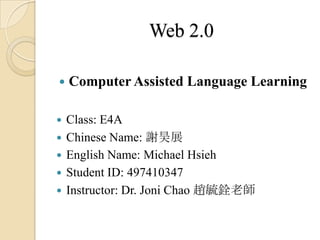
497410347 web2.0
- 1. Web 2.0 Computer Assisted Language Learning Class: E4A Chinese Name: 謝昊展 English Name: Michael Hsieh Student ID: 497410347 Instructor: Dr. Joni Chao 趙毓銓老師
- 2. Outline 1. Brief Definition 2. Characteristics 3. Technologies 4. Concepts 5. Usage 6. Web 2.0 in Education
- 3. 1. Brief Definition Web 2.0 is a loosely defined intersection of web application features that facilitate participatory information sharing, interoperability, user- centered design, and collaboration on the World Wide Web. A Web 2.0 site allows users to interact and collaborate with each other in a social media dialogue as creators (prosumers) of user-generated content in a virtual community, in contrast to websites where users (consumers) are limited to the passive viewing of text content that was created for them.
- 4. 2. Characteristics Web 2.0 websites allow users to do more than just retrieve information. By increasing what was already possible in "Web 1.0", they provide the user with more user-interface, software and storage facilities, all through their browser. This has been called "Network as platform" computing. Users can provide the data that is on a Web 2.0 site and exercise some control over that data. These sites may have an "Architecture of participation" that encourages users to add value to the application as they use it. Some scholars have made the case that cloud computing is a form of Web 2.0 because cloud computing is simply an implication of computing on the Internet.
- 5. 3. Technologies The client-side/web browser technologies used in Web 2.0 development are Asynchronous JavaScript and XML (Ajax), Adobe Flash and the Adobe Flex framework, and JavaScript/Ajax frameworks such as YUI Library, Dojo Toolkit, MooTools, jQuery and Prototype JavaScript Framework. Ajax programming uses JavaScript to upload and download new data from the web server without undergoing a full page reload.
- 7. 4. Concepts Web 2.0 websites include the following features and techniques: Andrew McAfee used the acronym SLATES to refer to them: 1. Search: Finding information through keywords. 2. Links: Connects information together into a meaningful information ecosystem using the model of the Web, and provides low-barrier social tools. 3. Tags: Categorization of content by users adding "tags"—short, usually one-word descriptions—to facilitate searching, without dependence on pre-made categories. Collections of tags created by many users within a single system may be referred to as "folksonomies" (i.e., folk taxonomies). 4. Extensions: Software that makes the Web an application platform as well as a document server. These include software like Adobe Reader, Adobe Flash player, Microsoft Silverlight, ActiveX, Oracle Java, Quicktime, Windows Media, etc. 5. Signals: The use of syndication technology such as RSS to notify users of content changes.
- 8. 5. Usage A third important part of Web 2.0 is the social Web, which is a fundamental shift in the way people communicate. The social web consists of a number of online tools and platforms where people share their perspectives, opinions, thoughts and experiences. Web 2.0 applications tend to interact much more with the end user. As such, the end user is not only a user of the application but also a participant by: Podcasting Blogging Tagging Contributing to RSS Social bookmarking Social networking
- 9. 6. Web 2.0 in education Web 2.0 technologies provide teachers with new ways to engage students in a meaningful way. "Children raised on new media technologies are less patient with filling out worksheets and listening to lectures" because students already participate on a global level. The lack of participation in a traditional classroom stems more from the fact that students receive better feedback online. Traditional classrooms have students do assignments and when they are completed, they are just that, finished. However, Web 2.0 shows students that education is a constantly evolving entity. Whether it is participating in a class discussion, or participating in a forum discussion, the technologies available to students in a Web 2.0 classroom does increase the amount they participate.
- 10. Application 1. Collaboration: peer-reviewing and editing, task or project-based method, online forum discussion 2. Tool: facebook, google, twitter, flicker, yahoo, blog, you tube, MSN, wikispaces…